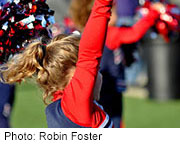
MONDAY, Oct. 22 (HealthDay News) — Cheerleading has become a competitive, year-round sport that features complex acrobatic stunts, which has led to an increase in the number and severity of injuries, experts say.
Now, new guidelines released by the American Academy of Pediatrics (AAP) urge coaches, parents and school officials to follow injury prevention guidelines, develop emergency plans and provide cheerleading programs with the same level of qualified coaches, medical care and injury surveillance as other sports.
“Most serious injuries, including catastrophic ones, occur while performing complex stunts such as pyramids,” guidelines co-author Dr. Jeffrey Mjaanes, a member of the AAP Council on Sports Medicine & Fitness, said in an academy news release. “Simple steps to improve safety during these stunts could significantly decrease the injury rate and protect young cheerleaders.”
Since 2007, there have been 26,000 cheerleading injuries in the United States each year. Cheerleading accounts for 66 percent of all catastrophic injuries that have occurred in high school female athletes over the past 25 years, according to the AAP.
The most common types of cheerleading injuries are sprains and strains in the lower extremities, followed by head and neck injuries.
The AAP guidelines recommend that:
- Cheerleading should be designated as a sport in all states, allowing for benefits such as qualified coaches, better access to medical care and injury surveillance.
- All cheerleaders should have a preseason physical, and access to qualified strength and conditioning coaches.
- Cheerleaders should be trained in all spotting techniques and only attempt stunts after demonstrating appropriate skill progression.
- Pyramid and partner stunts should be performed only on a spring/foam floor or grass/turf. Never perform stunts on hard, wet or uneven surfaces. Pyramids should not be more than two people high.
- Coaches, parents and athletes should have access to a written emergency plan.
- Any cheerleader suspected of having a head injury should be removed from practice or competition, and not allowed to return until he or she has clearance from a health professional.
The guidelines appeared online Monday, to coincide with a presentation at the AAP annual meeting in New Orleans. They will also be published in the November print issue of the journal Pediatrics.
More information
The Nemours Foundation has more about cheerleading safety.

